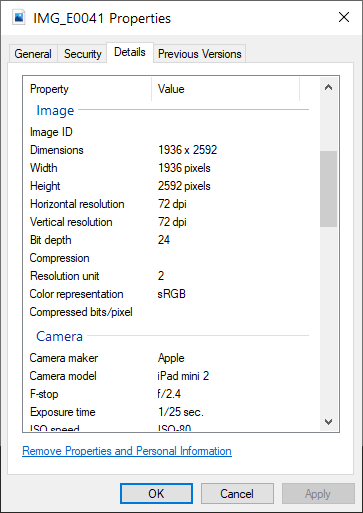Open AAE File
Information, tips and instructions
Rich image metadata
Each photo which was shot by a phone, digital camera or DSLR camera has metadata embedded in it. This metadata could be stored in different formats depending on the image file format. It can include multiple useful data points including location, author, ISO, image dimensions, etc.
Frequently this metadata is used by software to correctly process the image or to sort images in a specific manner. For example images that you took on your phone, camera, or the ones you uploaded to your computer could be sorted by date and time. This because each image file contains data and time when the image was taken. Such metadata also allows your phone, social networks, and other software to remind you about photos of important events from years ago.
Modern phones allow even more advanced processing based on image metadata. There is a feature called “map view” in both iOS and Android devices where you can view all your images overlayed on the map, thus making it significantly easier to navigate through your images by looking for images in specific locations.
Image metadata could be generated not only at the moment when the image is created (when photo or screenshot is being take) but later when you need it. For example modern devices allow advanced processing of the images when AI is used to find all people on the image and tag them with names. After such processing image metadata is enhanced with tags specifying who was found on the image. This allows to group image by person on the image or find all images with a specific person on it. More advanced algorithms are being introduced every year and now it is even possible to tag images depending on what kind of objects are contained there. For example iOS operating system allows finding all images with textual information in them, or all images with clouds, trees, water, etc. This makes image metadata extremely important. With growth of AI algorithms image metadata gets signficantly enhanced which may allow very effective search within the image database, or quick grouping and processing operations.
There are certain negative aspects of having rich metadata associated with image. One of the most important negative aspect is loss of privacy. Modern devices put enough metadata to the image that tracing where the image was taken and by which device is quite simplistic. That is why there are many software packages available which can completely strip metadata from the image. It may be beneficial if you want to share the image on the internet and don’t want someone tracking you based on it. That is why it is important to understand what kind of metadata is stored in the image. The easiest way to view the metadata associated with the image is to click right mouse button on the image file and in the popul menu select “Properties” in Windows OS and “Get Info” in Mac OS. On Windows OS you can even edit some of the metadata as shown below.

To be able to edit metadata on the Mac OS you will need more advanced software like Adobe Lightroom or Adobe Photoshop.
| AAE Quick Info | |
|---|---|
 Apple Image Sidecar File Apple Image Sidecar File | |
| MIME Type | |
 not applicable not applicable
| |
| Opens with | |
 Apple iOS and iPadOS Apple iOS and iPadOS | |
 Apple Photos Apple Photos | |
 Apple iCloud Apple iCloud |
